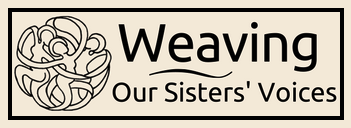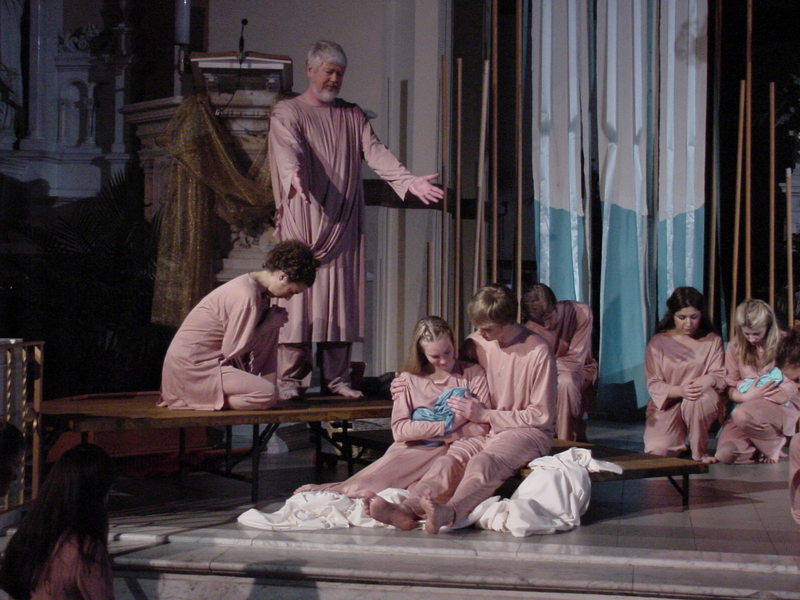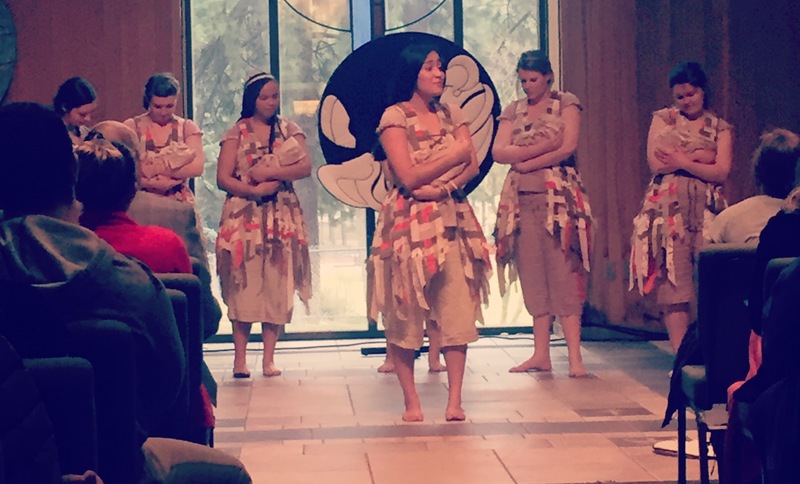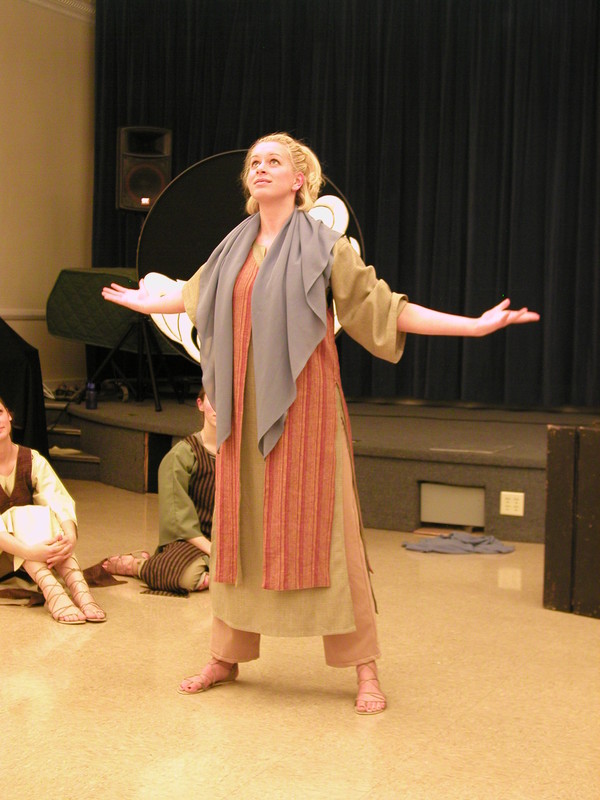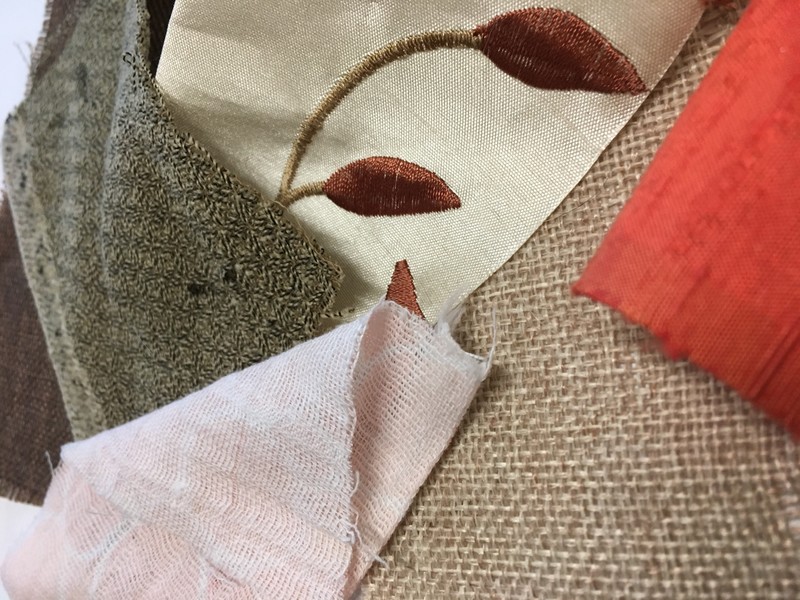Costuming
Weaving Our Sisters' Voices was still an experiment in 2006, so it was not part of the regular Gonzaga Theatre season. Instead, the performances were planned for all around the Spokane area in a touring circuit. From my touring experience with Medieval Mysteries, I knew the original Weaving Our Sisters’ Voices needed to be a simple production to tour. The circular logo image, a crate that could be sat on and that carried costumes and supplies, and a sound system was the entire travel load.
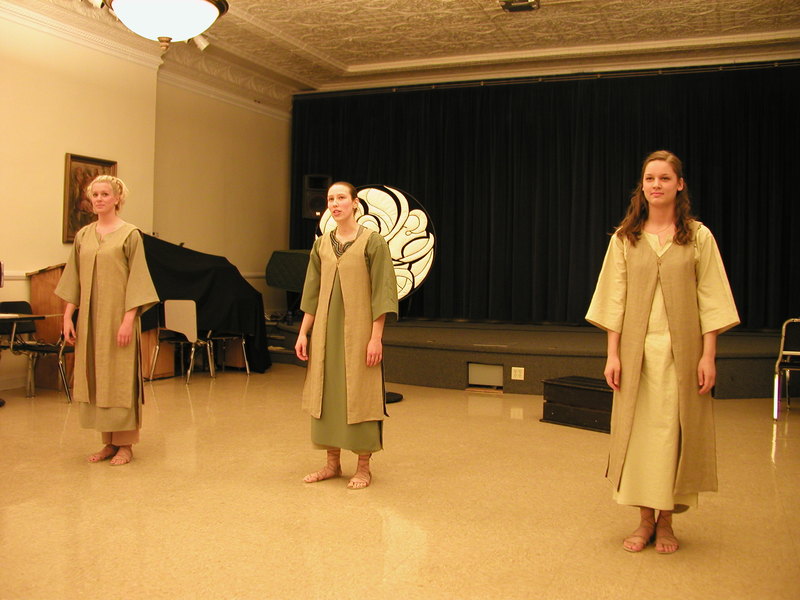
The cast of the touring production with the travelling medallion in the background. Photo courtesy of Suzanne Ostersmith
Costumes for this first production were designed by a student and realized by our staff costume manager with her student crew. The costumes were traditional long vests worn over tunics.
The vests were reversible with different colors and fabrics on each side so when they were turned inside out they could represent different characters. With this design there was a unity among the cast, but they still appeared to be individual women. But there was another elemental piece of fabric that was used to tell our stories.
In the Medieval Mysteries we had used blue fabric to dance with, which represented the babies born and then their slaying by Herod. This use of fabric to tell the story was then incorporated into Weaving Our Sisters’ Voices.
The Weaving Our Sisters' Voices split overdresses worn over pants with a double sided vest invoked a rough texture. The silkiness of the fabric scarves provided a wonderful contrast as they represented extra costume pieces, a river flowing, babies, or gifts of a king.
The question of footwear arises in every production, and in the first three Weaving Our Sisters' Voices productions, each one was different. Since we would be performing in various locations during the 2006 tour, shoes were vital. However, a typical leather jazz shoe didn’t seem hearty enough or time appropriate. My colleague and head of costuming, Summer Berry, shared a dance footwear catalogue with me, and I realized the best case scenario would be laced Grecian Sandals. It seemed crazy extravagant ($30 a pair) to purchase shoes for each of the performers, but the look was perfect. Summer ordered the shoes and confirmed that it would complete the costume design.
In all this excitement of design, the weight of costumes was never a consideration. But once we were touring, it was quite evident. The fabric choices hung nicely on the performer’s bodies but also added weight. The many layers (pants, over dresses, vests, blue fabric) were a lot to carry in and of themselves, but we also had a sound system and circular logo set pieces to manage. So for future touring performances I knew to take the weight of costuming and props into consideration.
The design process for the 2015 production began that summer, and one of the great delights in preparing for the new production was the blessing of getting to work with a new design team. Leslie Stamoolis had just completed her first year as the Costuming Professor at Gonzaga and had done the design for me for Jesus Christ Superstar. We met for dinner to begin discussing our ideas.
I had seen a piece of dance earlier that spring at the American College Dance Conference at Northern Colorado University, and the costumes were all white. There was something about it that I found haunting, but not angelic. We began our discussion with the practicalities of the production. My intention was to have nine to sixteen company members costumed in a monochromatic, diaphanous look. At that point I was still very much of the mind that I would have the opportunity to cast all strong, trained dancers and that I was going to push the work far more in a choreographic way, so I was encouraging ‘dance like’ costuming. She shared a desire to create her own textile using weaving. As she said, we would be missing a grand opportunity if we didn’t do some weaving in some way. She went away to do the visual research.
Leslie shared about how she was pondering the pallet and had collected photos from the location that had a specific look with colors. Then she was driving through the Palouse near Spokane and she was taken aback by the same color pallet! She enthusiastically shared what she had found with the look of wheat fields in the Palouse, and together we got excited about a little mantra of “Wheat not White.” This directed much of what she chose with the fabrics used for weaving the dresses. Her final design included many colors from the wheat fields, made from fabric constructed of natural fibers. It was fun to see the costumes developing on the dress forms in the costume shop, and I particularly liked that they weren’t overly tidy in appearance. Because of the fabrics she chose, the edges frayed and created some life along the open sides of the weaving.
Leslie shared many sketches during the design process; in her initial thumbnail sketches she was working with various shoulder effects to convey strength. Also from her visual research, she took inspiration from the middle and far Eastern traditions of dresses or tunics over trousers.
Collaboration is an intrinsic element of the performing arts and something I deeply value. But that is not to say it isn’t challenging. I had a very specific vision and a strong opinion of the diaphanous, or see-through, quality of the costumes. From our discussions, I thought that the costume designer saw that as well. But through the process, it became apparent that a woven textile with texture was a more important aesthetic to this production that something see-through and flowy. As a collaborator, I have to assess, how much do I insist in my original views, and how much do I honor another’s vision? This is also a complex internal negotiation. Over the years, I have found that most often the collaborative process yields greater work than solo visions, so while I may have a starting point in my mind, the journey of collaboration takes us where the design is supposed to go. In the end, there was a richness to the costumes through the many layers that strengthened the production.
Suzanne Ostersmith
